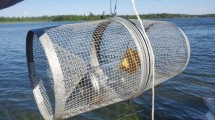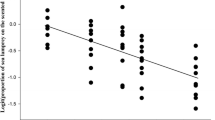Abstract
Chemical and visual sources of information are used by aquatic prey during risk assessment. Here, we test the behavioral response of littoral prey fish to combinations of chemical alarm cues (skin extract) and the visual presence of a fish shoal. We scented minnow traps with either alarm cues or water (control) placed inside the trap, a jar that contained either a fish shoal or nothing (control), and recorded the number and species of fish captured. We predicted that chemical alarm cues would reduce the number of fish captured and that a fish shoal would increase the number of fish captured. The predicted effect of chemical and visual cues combined depended on the nature of the interaction. We found that the lowest catch rate was for the combination of alarm cue + no shoal, but the highest catch rate occurred for the combination of alarm cue + shoal. Fish shoal + water had the second highest catch rate and no shoal + water had the second lowest catch rate. We conclude that chemical alarm cues induce area avoidance in the absence of a shoal, but a strong behavioral proclivity to increase shoal cohesion in the presence of a shoal. The presence of a shoal in the traps induced alarmed fish to shoal with them and thus, enter the traps. This occurred even though traps were the source of the alarm cue.



Similar content being viewed by others
References
Brown GE, Chivers DP, Smith RJF (1997) Differential learning rates of chemical versus visual cues of a northern pike by fathead minnows in a natural habitat. Environ Biol Fish 49:89–96
Brown GE, Godin J-GJ (1997) Anti-predator responses to conspecific and heterospecific skin extracts by threespine sticklebacks: Alarm pheromones revisited. Behaviour 134:1123–1135
Brown GE, Godin J-GJ (1999a) Who dares, learns: chemical inspection behaviour and acquired predator recognition in a characin fish. Anim Behav 57:475–481
Brown GE, Godin J-GJ (1999b) Chemical alarm signals in wild Trinidadian guppies (Poecilia reticulata). Can J Zool 77:562–570
Brown GE, Le Blanc VJ, and Porter (2001) Ontogenetic changes in the response of largemouth bass (Micropterus salmoides, Centrarchidae, Perciformes) to heterospecific alarm pheromones. Ethology 107:401–414
Chivers DP, Smith RJF (1994) Intra- and interspecific avoidance of marked areas with skin extract from brook sticklebacks (Culaea inconstans). J Chem Ecol 20:1517–1524
Chivers DP, Smith RJF (1998) Chemical alarm signalling in aquatic predator-prey systems: a review and prospectus. Ecoscience 5:338–352
Chivers DP, Wisenden BD, Smith RJF (1995) The role of experience in the response of fathead minnows (Pimephales promelas) to skin extract of Iowa darters (Etheostoma exile). Behaviour 132:665–674
Chivers DP, Wisenden BD, Smith RJF (1996) Damselfly larvae learn to recognize predators from chemical cues in the predator's diet. Anim Behav 52:315–320
Commens AM, Mathis A (1999) Alarm pheromones of rainbow darters and responses to skin extracts of conspecifics and congeners. J Fish Biol 55:1359–1362
Frisch K von (1938) Zur Psychologie des Fische-Schwarmes. Naturwissenschaften 26:601–606
Hartman EJ, Abrahams MV (2000) Sensory compensation and the detection of predators: the interaction between chemical and visual information. Proc R Soc Lond B 267:571–575
Hazlett BA (1990) Source and nature of disturbance-chemical system in crayfish. J Chem Ecol 16:2263–2275
Hoare DJ, Ruxton GD, Godin J-GJ, Krause J (2000a) The social organization of free-ranging fish shoals. Oikos 89:546–554
Hoare DJ, Krause J, Peuhkuri N, Godin J-GJ (2000b) Body size and shoaling in fish. J Fish Biol 57:1351–1366
Hossain MAR, Tanaka M, Masuda R (2002) Predator-prey interaction between hatchery-reared Japanese flounder juvenile, Paralichthys olivaceus, and sandy shore crab, Matuta lunaris: daily rhythms, anti-predator conditioning and starvation. J Exp Mar Biol Ecol 267:1-14
Irving PW, Magurran AE (1997) Context-dependent fright reactions in captive minnows: the importance of naturalness in laboratory experiments. Anim Behav 53:1193–1201
Kats LB, Dill LM (1998) The scent of death: Chemosensory assessment of predation risk by prey animals. Ecoscience 5:361–394
Kerby JL, Kats LB (1998) Modified interactions between salamander life stages caused by wildfire-induced sedimentation. Ecology 79:740–745
Kiesecker JM, Chivers DP, Marco A, Quilchanos C, Anderson MT, Blaustein AR. (1999) Identification of a disturbance signal in larval red-legged frogs Rana aurora. Anim Behav 57:1295–1300
Krause J, Godin J-GJ, Brown D (1998) Body length variation within multi-species fish shoals: the effects of shoal size and number of species. Oecologia 114:67–72
Krause J, Hoare DJ, Croft D, Lawrence J, Ward A, Ruxton GD, Godin J-GJ, James R (2000) Fish shoal composition: Mechanisms and constraints. Proc R Soc Biol Sci B 267:2011–2017
Lawrence BJ, Smith RJF (1989) Behavioral response of solitary fathead minnows, Pimephales promelas, to alarm substance. J Chem Ecol 15:209–219
Lima SL, Dill LM (1990) Behavioral decisions made under the risk of predation: a review and prospectus. Can J Zool 68:619–640
Magnhagen C (1992) Parental care and predation risk in fish. Ann Zool Fenn 29:227–232.
Magurran AE, Irving PW, Henderson PA (1996) Is there a fish alarm pheromone? A wild study and critique. Proc R Soc Lond B 263:1551–1556
Mathis A, Smith RJF (1992) Avoidance of areas marked with a chemical alarm substance by fathead minnows (Pimephales promelas) in a natural habitat. Can J Zool 70:1473–1476
Mathis A, Smith RJF (1993a) Chemical labeling of northern pike (Esox lucius) by the alarm pheromone of fathead minnows (Pimephales promelas). J Chem Ecol 19:1967–1979
Mathis A, Smith RJF (1993b) Chemical alarm signals increase the survival time of fathead minnows (Pimephales promelas) during encounters with northern pike (Esox lucius). Behav Ecol 4:260–265
Mathis A, Smith RJF (1993c) Intraspecific and cross-superorder responses to chemical alarm signals by brook stickleback. Ecology 74:2395–2404
Mathis A, Vincent F (2000) Differential use of visual and chemical cues in predator recognition and threat-sensitive predator avoidance responses by larval newts (Notophthalmus viridescens). Can J Zool 78:1646–1652
Mathis A, Chivers DP, Smith RJF (1996) Cultural transmission of predator recognition in fishes: intraspecific and interspecific learning. Anim Behav 51:185–201
Mirza RS, Chivers DP (2000) Predator-recognition training enhances survival of brook trout: evidence from laboratory and field-enclosure studies. Can J Zool 78:2198–2208
Mirza RS, Chivers DP (2001). Are chemical alarm signals conserved within salmonid fishes? J Chem Ecol 27: 1641–1655
Mirza RS, Scott JJ, Chivers DP (2001). Differential responses of male and female red swordtails to chemical alarm cues. J Fish Biol 59:716–728
Pfeiffer W (1977) The distribution of fright reaction and alarm substance cells in fishes. Copeia 1977:653–665
Pitcher TJ (1986) Functions of shoaling behaviour in teleosts. In: Pitcher TJ (ed) The Behaviour of teleost fishes. Croom Helm, Sydney, pp 294–337
Smith RJF (1976) Seasonal loss of alarm substance cells in North American cyprinoid fishes and its relation to abrasive spawning behaviour. Can J Zool 54:1172–1182
Smith RJF (1982) Reaction of Percina nigrofasciata, Ammocrypta beani, and Etheostoma swaini (Percidae, Pisces) to conspecific and intergeneric skin extracts. Can J Zool 17:2253–2259
Smith RJF (1992) Alarm signals in fishes. Rev Fish Biol Fish 2:33–63
Wisenden BD, Chivers DP, Brown GE, Smith RJF (1995) The role of experience in risk assessment: avoidance of areas chemically labelled with fathead minnow alarm pheromone by conspecifics and heterospecifics. Ecoscience 2:115–122
Wisenden BD, Chivers DP, Smith RJF (1997) Early warning in the predation sequence: a disturbance pheromone in Iowa darters (Etheostoma exile). J Chem Ecol 21:1469–1480
Wisenden BD, Vollbrecht KA, Brown JL (2003) Is there a fish alarm cue? Affirming evidence from a wild study. Anim Behav (in press)
Zulandt Schneider RA, Moore PA (2000) Urine as a source of conspecific disturbance signals in the crayfish Procambarus clarkii. J Exp Biol 203:765–771
Acknowledgements
Field assistance at Deming Lake was provided by (2000): Waima Azizi, Daniel Budge, Jennifer Dehn, Delaina Hartung, Mary Kosuth, Doug Ludemann, Dana Peltier, and Lizbeth Zaro, and (2001): Nick Altringer, Alina Baum, Annie Felix, Katie Haggblom, Kim Harmon, Erica Hatfield, Katie Johnson, Alison La Pean, Carlee Olson, and Summer Smith. Logistical support was provided by Jon Ross of the Itasca Biological Field Station. This research was funded by an NSERC operating grant to Douglas Chivers and a faculty research grant to Brian Wisenden from the Minnesota State University Moorhead College of Social and Natural Sciences. IACUC protocol number for work in Feedlot Pond was 19920077, issued to Douglas Chivers. IACUC protocol number from the University of Minnesota to Brian Wisenden for use at the Itasca Biological Field Station was 0005A51841, issued to Brian Wisenden.
Author information
Authors and Affiliations
Corresponding author
Additional information
Communicated by A. Mathis
Rights and permissions
About this article
Cite this article
Wisenden, B.D., Pollock, M.S., Tremaine, R.J. et al. Synergistic interactions between chemical alarm cues and the presence of conspecific and heterospecific fish shoals. Behav Ecol Sociobiol 54, 485–490 (2003). https://doi.org/10.1007/s00265-003-0653-9
Received:
Revised:
Accepted:
Published:
Issue Date:
DOI: https://doi.org/10.1007/s00265-003-0653-9




